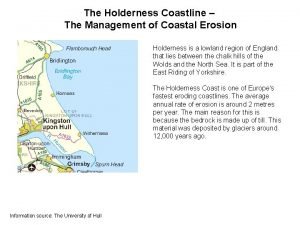The factors that have led to the Holderness










- Slides: 10

The factors that have led to the Holderness coast suffering from erosion and the potential costs of this eroding coastline ___________________________ The Holderness Coastline

Where is Holderness • The Holderness Coast is located on the east coast of England. It extends 61 km from Flamborough in the north to Spurn Point in the south.

What issues face Holderness? • Holderness Coast is fastest eroding stretch of coastline in Europe – an average of 2 metres fall into the North Sea each year • Locally, rates of erosion have been up to 10 -20 m with waves biting coast away • Over 30 villages have been lost since Roman times, erosion has been taking place for last 6000 yrs

The Factors Affecting Erosion There are three main reasons for this erosion: 1. Geology (rock type) 2. The fetch 3. Longshore drift and beach material

Geology The boulder clay has very little resistance to erosion, especially when wet, making it very susceptible to erosion The two main types of rock on the Holderness coast are Boulder clay and chalk

Fetch Holderness is exposed to winds and waves from the north-east, which have a small fetch of about 500 -800 km. This is not far, but the coast at Holderness is attacked by other factors, affecting the ferocity of the waves.

Factors Affecting the Fetch • Currents – or swell – which circulate around the UK from the Atlantic and into the North sea. The Atlantic fetch is 5000 km or more, and its currents add energy to waves in the North sea. Therefore, there are often powerful destructive waves along this coastline. • Low pressure weather systems passing over the North sea are often intense, and locally produce very strong winds and waves. • Small, almost enclosed seas, like the North sea, often generate huge waves during storms. Waves move within the sea but cannot disperse their energy – rather like water slopping up against the side of a washbasin • The sea floor is deep along the Holderness coast. Therefore, the waves reach the cliffs without first being weakened by friction with shallow beaches.

Longshore Drift and Beach Material The beaches at Holderness are its main problem. Boulder clay erodes to produce mainly clay particles, which are easily transported out to sea, rather than accumulating close to the cliffs as beach sand. Although there are beaches, there is never enough sand to stop the waves reaching the cliff base at high tide. What little sand is produced is taken southwards by longshore drift, leaving the Holderness cliffs poorly protected against wave attack. Eventually, a small amount of beach material reaches a spit at Spurn Head, where it accumulates.

Holderness Coast – Cliff Processes Rain water enters cracks Cracks formed by wetting and drying Boulder Clay Cliff Material slumps down the cliff Removal of slumped material by sea Slip plane developing Sea Beach

 Phân độ lown ngoại tâm thu
Phân độ lown ngoại tâm thu Block xoang nhĩ độ 2 type 1
Block xoang nhĩ độ 2 type 1 Thơ thất ngôn tứ tuyệt đường luật
Thơ thất ngôn tứ tuyệt đường luật Thơ thất ngôn tứ tuyệt đường luật
Thơ thất ngôn tứ tuyệt đường luật Walmart thất bại ở nhật
Walmart thất bại ở nhật Tìm độ lớn thật của tam giác abc
Tìm độ lớn thật của tam giác abc Con hãy đưa tay khi thấy người vấp ngã
Con hãy đưa tay khi thấy người vấp ngã Tôn thất thuyết là ai
Tôn thất thuyết là ai Gây tê cơ vuông thắt lưng
Gây tê cơ vuông thắt lưng Sau thất bại ở hồ điển triệt
Sau thất bại ở hồ điển triệt Holderness coastline
Holderness coastline



















